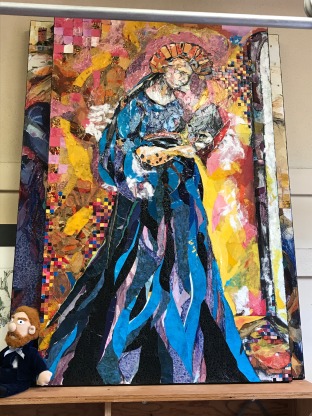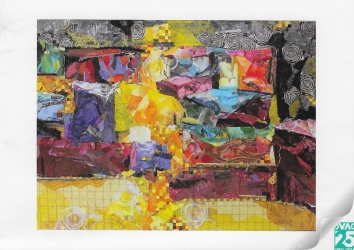 Jes McMillan combined her skill and experience as a mosaic artist with her passion for community to create her career as a humanitarian artist.
Jes McMillan combined her skill and experience as a mosaic artist with her passion for community to create her career as a humanitarian artist.
In the beginning…
While growing up in Kettering, Miamisburg, Dayton and Columbus, Ohio, Jes McMillan always “wanted to be an artist”. In elementary school, she “loved going into the art room. (It was her) favorite class”. Her talent and interest were recognized early when the teacher chose her in second grade to “paint a window of the art room for the holidays… Usually (they) only let the 6th graders paint the windows”.
How did Jes become a mosaic artist?
Jes followed her passion for art in high school. “I took every art class that was available”. She gained her first experience with handling, cutting and grinding glass when she did a fine design stained glass stepping stone project in art class. The project taught her how to cut the shapes exactly so they would fit together in the pattern with even spacing throughout.
“I did my first mosaic in high school at age 16. I got a piece of wood from the garage, 2’ tall by 4’ wide” and used glass for the pattern. Jes made a second piece which she “traded to my art teacher for a set of all the tools you need to do the glass, so then I was on my way”.
What did Jes do after high school?
After Jes graduated, she pursued industrial design. “I’ve always had a building and engineering type of mind”. She earned her Associates in Science degree in Industrial Design at the Art Institute of Pittsburgh. They recognized her talent and skills with mosaic art immediately and employed her to represent the Art Institute at festivals and to teach workshops on mosaics.
While she was going to school, Jes also worked at the YMCA. By the time she graduated from the Art Institute, she was advancing “up the ladder through the child care and I wanted to be a director”. She enrolled at Point Park University in Pittsburgh to get the necessary credits for that position. She majored in Art History and Child Development and graduated with a Bachelor of Arts in Design & Applied Arts.
What did Jes do when she returned to Dayton?
Pittsburgh “was a great city… I loved that experience”, but family ties brought Jes back to Dayton in 2005. Despite her experience in child care at the Pittsburgh YMCA, Jes discovered the Dayton YMCA lacked openings for child care directors. “I did try being an after-school site director, but I’d already passed that point and I didn’t want to take steps back”.
Jes secured a job as an industrial designer in Franklin, Ohio, but had the misfortunate to injure her hand. “I was dealing with a lot of models and you need your hands”. Shortly thereafter, she was laid off.

Next, Jes combined her background in art with her training in child development at K-12 Gallery & Teen Educational & Joint Adult Studio in downtown Dayton as a mosaic art class instructor. In order to supplement her income, she also managed Design Sleep, a high-end organic bedding store in Yellow Springs, Ohio.
How did Jes start combining mosaic art and community work?
Jes created her “first community collaborative piece” while teaching mosaic art at the K-12 Gallery & TEJAS. She led others to make “huge pieces of art that were affecting the community in a really big way. So that kind of changed the course for me right away”. 
For almost eight years, Jes taught and directed community art projects at the K-12 Gallery & TEJAS. In November 2013, she “parted ways with them to create my own vehicle for community work”. While she considered what that meant, she worked as a database manager for Healthy Alternative, an independent chain of health food grocery stores. In 2015 she founded a 501(c)(3) nonprofit organization, The Mosaic Institute of Greater Dayton, to carry out her commitment to community through its mission: To Inspire, Empower and Unify Community Through Art.
Through contacts made while volunteering at One Bistro, a nonprofit restaurant in Miamisburg, Ohio, Jes found a building with 15,000 square feet available in the same town. In September 2015, The Mosaic Institute  opened a walk-in mosaic studio with bins of pre-cut glass sorted by color that customers could use to create “make it and take it” mosaics. The studio offered a full class schedule, private parties and other events.
opened a walk-in mosaic studio with bins of pre-cut glass sorted by color that customers could use to create “make it and take it” mosaics. The studio offered a full class schedule, private parties and other events.
Since 2015 Jes has involved The Mosaic Institute in almost 20 community mural projects, both paint and mosaic, in Miamisburg. “I have done mosaic murals in every single elementary school in Miamisburg but one”, and that elementary school is scheduled to create one during the 2018-2019 school year. Miamisburg High School is also on the schedule. Eventually Jes “will have mosaiced with every child in” Miamisburg.
 For the 2017 River Blast Festival, Jes and The Mosaic Institute partnered with the City of Miamisburg to create a giant painted mosaic on 350 feet of levee wall along the Great Miami River. Jes and her Mosaic Institute team taped the giant mosaic pattern on the levee and gave each participant a “paintbrush with the right color and directed them towards the spaces… Everybody from babies to seniors got involved in that mural”. The project made the City a semifinalist for the 2017 Governor’s Award for Parks & Recreation.
For the 2017 River Blast Festival, Jes and The Mosaic Institute partnered with the City of Miamisburg to create a giant painted mosaic on 350 feet of levee wall along the Great Miami River. Jes and her Mosaic Institute team taped the giant mosaic pattern on the levee and gave each participant a “paintbrush with the right color and directed them towards the spaces… Everybody from babies to seniors got involved in that mural”. The project made the City a semifinalist for the 2017 Governor’s Award for Parks & Recreation.

During its first year, The Mosaic Institute also used their building’s big open space to hold ten art shows with music, performance art, and visual art. It was “a lot of fun”, but, due to the heating and cooling expenses, “the building ended up being just a monster”. Jes needed to relocate The Mosaic Institute.
Since The Mosaic Institute had been active in the community, Jes negotiated with the City of Miamisburg for some space to open a community art center. Her dream is to use her “skills and abilities in partnership with (the City of Miamisburg) to build a Rosewood Arts Center, a city-sustained arts program”. The City did provide some space in a community park, “but it was like starting over from square one”.
Why did Jes move The Mosaic Institute to downtown Dayton?
While Jes was wrestling with relocation, her friend, Mike Bisig, bought the building for

Mike’s Bike Park, which included extra space. Jes had spent many years as a young artist at The Front Street Building and knew it always had a waiting list for studio space. When she saw the available space in Mike’s building, she “instantly thought it was a good opportunity to rent these out to artists”.
Jes faced a choice: “do I start over in Miamisburg or do I take this new opportunity? It puts me back in the city (Dayton), which is where I want to be and eventually it could be self-sustaining”. In Miamisburg, Jes relied on income, grants and donations generated by The Mosaic Institute. Funding was always difficult. The Crane Studios Market business model predicted a more consistent cash flow. “Once I rent these out, I’ve got a commitment”.

Consequently, she moved The Mosaic Institute to 221 Crane Street, Dayton, and “opened up Crane Studios Market to be a tenant in my own arts market”.

“I started out with 13 studios. Each one (is an) individual shop where artists of different types are doing their own galleries/retail business”. Jes priced the rent, which includes internet access, to be attractive to entrepreneurial artists testing the risk of opening a studio gallery. “Can I get customers? Can I market? Can I switch it up enough in my shop?”
Studios in Crane Studios Market
The leases require the artists to open their shops whenever Crane is open: each 1st Friday, 6 p.m. – 9 p.m., and every Saturday, Noon – 5 p.m. For those lacking the time to run a studio shop, Jes rents wall space and handles the sales of that artist’s work.
Crane opens a new show with a visiting artist every first Friday. That visiting artist returns on the second Saturday to give an artist talk from 3 p.m. to 5 p.m. A free bourbon tasting is included.
“We’ve grown into an awesome team. We still have a lot to learn… I’m coming up on my first year as far as managing tenants and spaces, but it’s been great”.

What community work is Jes doing in Dayton?
When Crane began attracting suburban residents to the first Friday artist talks, Jes realized “there was a huge disconnect” between the suburbs and the art activity in the city. Many people are unaware that East Dayton contains the highest concentration of artists in Dayton. In order to raise awareness, Jes developed the East Dayton Arts District.

Her immediate goal is to brand the area and “create some unity with the artists and the arts here and just try to change the face of the East side. In a collaborative setting, art has the power to transcend the barriers of division in every way”.
Her first steps to brand the district involved setting up the website and painting the First Street overpass to be a gateway to the area. The next step will require attending neighborhood association meetings in the district to get them on board. “I think the more people that we get on board, the easier it will be for us to build the district”.
Additionally, Jes is spearheading creation of a memorial for victims of the opioid epidemic, The Wall of Perseverance. Her speech at the 2018 UpDayton Summit earned a grant for seed money for the project. The award also gave her “a team of all these professional people who do all these awesome things”.
The project will invite people to write the name of a loved one lost to opioids on the back of a tile and incorporate it into the 3-D memorial. Jes envisions it as a way “to physically do something to help rebuild broken lives”. We will “make Dayton the Capitol of Healing”.
Jes’ reflections:

The most difficult thing Jes does now is “managing the tenants, the different artistic personalities. I’m just trying to gather the team; that is the challenge… What an adventure! If you asked me two years ago, would I ever be a landlord to 13 people, no way that I would’ve said ‘yes’ to that”.
Jes would like to get back to doing her own mosaic work. “I haven’t had a show yet and I really would really like to”. She has been doing mosaics for 20 years now and says, “I really enjoy it, so getting back to that would be great.”
Jes’ career observations:

- Explore experiences to find out what it is that matches with you as a person
- Remember to meet people, network and communicate in order to make projects come alive
- Build leadership experience by getting people active and involved in projects that make a difference
- Infuse humanitarian acts, caring and giving, into your career regardless of what you do, whether you’re doing a job you love or not

“I’ve definitely hit this point with opening Cranes and The Mosaic Institute here that I have this amazing team of professional creative people here with me that are helping me do everything with the community work; they’re very supportive. Team Crane and Team Mosaic are all kind of merging together… a lot of us really care and are invested and excited about making a difference… This is my 20th year as a mosaic artist and almost all of my career out of college has been dedicated to community”.
“Those who can have the responsibility to”.

You can find more information about Jes at:
City of Miamisburg levee painting (WDTN.com, December 14, 2017)
Art projects in Miamisburg with The Mosaic Institute (Dayton Daily News, August 26, 2016)
Meet 2018 Artfest Featured Artist Jes McMillan (Dayton Local.com, August 22, 2018)
Dayton Wall of Perseverance to Memorialize Opioid Epidemic Victims with Art (WYSO, May 28, 2018)







 Katrina’s mentor at Centerville high school recognized teaching wasn’t her calling. He advised, “If you’re thinking of leaving, don’t stay longer than five years or you’ll just get stuck”. Katrina took his advice and left after five years. “I knew I really wanted to write and I knew that this was not a match for the writing life”.
Katrina’s mentor at Centerville high school recognized teaching wasn’t her calling. He advised, “If you’re thinking of leaving, don’t stay longer than five years or you’ll just get stuck”. Katrina took his advice and left after five years. “I knew I really wanted to write and I knew that this was not a match for the writing life”.




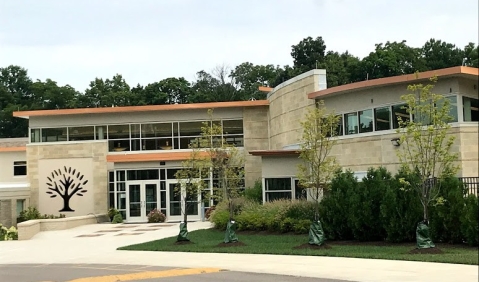







 Lisa identified the factors which helped the Chicago club draw an audience: the nearby presence of a
Lisa identified the factors which helped the Chicago club draw an audience: the nearby presence of a  The club in question was Jokers Comedy Cafe. Mike Bowling, creator of the Pound Puppy stuffed animals, had opened the club in 1985 and “had never made a penny”. Lisa agreed to come to Dayton for 90 days. “We’ll turn the club around and get the numbers all in line, then we’ll find a manager”. After about 60 days, Lisa reported the club’s numbers looked good and recommended they hire a manager. Instead, Bowling offered her the job for a year. Lisa declined, because “Dayton was probably the smallest city I’d been in” and she knew nothing about it. “When I came here for 90 days, all I did was work that club”.
The club in question was Jokers Comedy Cafe. Mike Bowling, creator of the Pound Puppy stuffed animals, had opened the club in 1985 and “had never made a penny”. Lisa agreed to come to Dayton for 90 days. “We’ll turn the club around and get the numbers all in line, then we’ll find a manager”. After about 60 days, Lisa reported the club’s numbers looked good and recommended they hire a manager. Instead, Bowling offered her the job for a year. Lisa declined, because “Dayton was probably the smallest city I’d been in” and she knew nothing about it. “When I came here for 90 days, all I did was work that club”.

 They learned that Mehlman hadn’t paid the sales tax, as well as owing numerous vendors. Lisa determined that Jokers owed around $65,000 in back sales taxes and even more to unpaid vendors. Bowling agreed that she would run Jokers for one year and at the end of the year, she would buy the business for the remaining amount of debt. A year later, Jokers was hers. Eventually, she bought the building, too.
They learned that Mehlman hadn’t paid the sales tax, as well as owing numerous vendors. Lisa determined that Jokers owed around $65,000 in back sales taxes and even more to unpaid vendors. Bowling agreed that she would run Jokers for one year and at the end of the year, she would buy the business for the remaining amount of debt. A year later, Jokers was hers. Eventually, she bought the building, too.








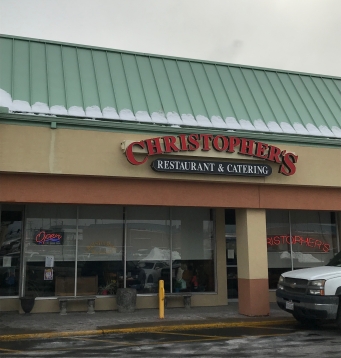



















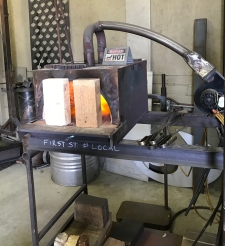












 Brent Johnson combined the business and customer service skills he learned in retail and occupational therapy to build his salon business. Today, he and his partners own and operate six
Brent Johnson combined the business and customer service skills he learned in retail and occupational therapy to build his salon business. Today, he and his partners own and operate six 













 Relocating to Cross Pointe Shopping Centre in Centerville, Ohio allowed Maria to expand her market to individual consumers. “Immediately the reception and the climate and the whole direction was very strongly a positive ‘yes’”.
Relocating to Cross Pointe Shopping Centre in Centerville, Ohio allowed Maria to expand her market to individual consumers. “Immediately the reception and the climate and the whole direction was very strongly a positive ‘yes’”. Maria officially launched Maria Gossard Designs in March 2016 with an expanded, trendsetting team. Jeff now works part-time, as he is back in school. Roger Owsley, a nationally recognized designer, leads the graphic division. Maria added an experienced silkscreen printer, Bobby Trimbach, to offer items such as golden edges silkscreened on invitations, and limited edition posters for bands and artists around the country. A retired pressman, Mark Bundy, runs the recently acquired letterpress machines. “I’m proud of our fleet of
Maria officially launched Maria Gossard Designs in March 2016 with an expanded, trendsetting team. Jeff now works part-time, as he is back in school. Roger Owsley, a nationally recognized designer, leads the graphic division. Maria added an experienced silkscreen printer, Bobby Trimbach, to offer items such as golden edges silkscreened on invitations, and limited edition posters for bands and artists around the country. A retired pressman, Mark Bundy, runs the recently acquired letterpress machines. “I’m proud of our fleet of 

 She invested in educational, entrepreneurial and leadership materials, and workshops with coaches like
She invested in educational, entrepreneurial and leadership materials, and workshops with coaches like  “Our dream is to bring to Dayton an elevated printing service that only exclusive neighborhoods in bigger cities have and help put our city on the map. It’s all about educating our community and serving them with products” so they don’t wish that they lived in New York, Chicago or Los Angeles. “Instead they’ll say, ‘I got this done in Dayton, Ohio’”.
“Our dream is to bring to Dayton an elevated printing service that only exclusive neighborhoods in bigger cities have and help put our city on the map. It’s all about educating our community and serving them with products” so they don’t wish that they lived in New York, Chicago or Los Angeles. “Instead they’ll say, ‘I got this done in Dayton, Ohio’”.






 stores in Reading, Pa. as a model, he opened The Mart Factory Outlet in 1982. The Mart offered sporting goods, housewares, clothing and appliances. “It started out doing real good. I would get 10% of the sales as the rent; we collected the money and paid the sales tax. Then that fell apart…so I put my own merchandise in here –
stores in Reading, Pa. as a model, he opened The Mart Factory Outlet in 1982. The Mart offered sporting goods, housewares, clothing and appliances. “It started out doing real good. I would get 10% of the sales as the rent; we collected the money and paid the sales tax. Then that fell apart…so I put my own merchandise in here – 




 lot filled full with trucks and they wanted that lot for baseball.” In 2001 Sandy bought the site with the old B&O Railroad freight terminal and parking for the trucks next to 2nd Street Public Market in Dayton. Based on the concept of the Springfield, Ohio
lot filled full with trucks and they wanted that lot for baseball.” In 2001 Sandy bought the site with the old B&O Railroad freight terminal and parking for the trucks next to 2nd Street Public Market in Dayton. Based on the concept of the Springfield, Ohio  Sandy executed his pivot by revamping the market as
Sandy executed his pivot by revamping the market as






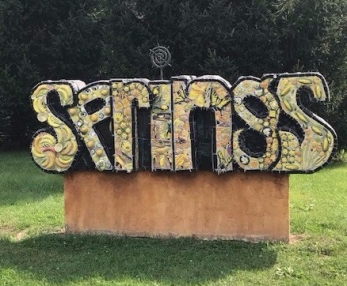





 Marsha Pippenger’s determination to make art is the steel thread running throughout her career. Like many practicing artists, Marsha has held a variety of jobs, but regardless of whether she was in advertising, retail or education, art remained her focus. I asked Marsha how she crafted her career. The highlights of her story follow.
Marsha Pippenger’s determination to make art is the steel thread running throughout her career. Like many practicing artists, Marsha has held a variety of jobs, but regardless of whether she was in advertising, retail or education, art remained her focus. I asked Marsha how she crafted her career. The highlights of her story follow.






